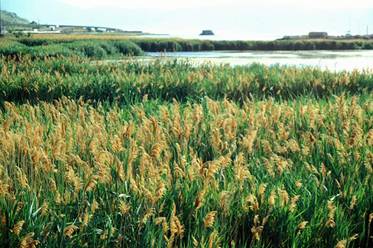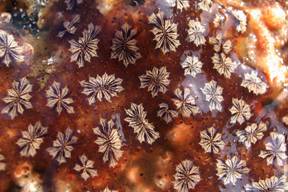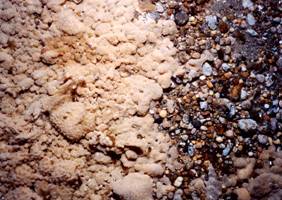Ecology of the Northeast US Continental Shelf
Invasive Species
Aquatic invasive species are also referred to as aquatic nuisance species. There is no universally agreed-on definition for these species. The national Aquatic Nuisance Species Task Force defines them as “organisms introduced into new habitats … that produce harmful impacts on aquatic natural resources in these ecosystems and on the human use of these resources”. Some invasive species, like sea lampreys and zebra mussels, are well-known to the public and have had large, well-documented impacts on ecosystems. Other invasives may dominate estuarine and coastal biotic communities but are less familiar, e. g., some tunicates (also called sea squirts, and discussed further below). Still other exotic species may be abundant but are less dominant or “invasive”. The geographic origins of invasive species are often uncertain, and some species assumed to be invasive may actually be native to an area, but for some reason(s) have become more abundant and important in the ecosystem; species with uncertain origins are termed “cryptogenic”.
Invasive species are introduced to new areas by several primary means of spread (“vectors”). The water and sediment in ballast tanks of large ships often harbor some life stage(s) of these species, as do ship hulls, anchors and chains; the introduction of invasives has increased with the upswing in global shipping. Recreational boating can also transfer species to new areas. When exotic species are brought to an area for aquaculture, both the aquaculture species and their associated biota can become invasive. This is also true of species purposely introduced for fishing or for biological control of pest species. Other common vectors of species introductions include intentional or accidental release from public or private aquaria, use of fishing baits, and transport of live organisms for food.
Species introduced to new areas are often not accompanied by the predators, parasites and diseases that may have kept them in control in their native habitats. Also, native species may not be adapted and resistant to the kinds of competition and predation the exotic species bring. For these reasons, exotic species may become dominant and invasive in new areas. Often they first gain a foothold at sites with few or no native species present. Such open sites may be created by natural disturbance, e. g., on rocky coasts where storms have removed native biota. However, invasions frequently begin on man-made structures such as ships, docks, buoys, bulkheads, aquaculture structures, and oil rigs. Species-rich native communities are sometimes more resistant to invasion, since they have fewer empty ecological niches, and greater likelihood that some of the native species can compete with or prey on the invaders. But there is an “invasion paradox”– invasive species themselves, or through the added structure they may provide, can increase diversity, and highly diverse native communities are also often hotspots for exotic species. There probably can be no simple general theory of the relationship between diversity and invasibility.
Invasive species in northeast US estuarine and marine ecosystems

One of the most conspicuous invasive species in our area is the common reed, Phragmites australis (Figure 1). In salt marshes that have been disturbed, e. g., by impeding exchange of water with the adjacent estuary, this reed often replaces smooth cordgrass, Spartina alterniflora (the dominant vegetation in most east coast marshes).
The reed-cordgrass relationship illustrates some of the complexities invasive species can present. Cordgrass is usually considered more valuable to most marsh-using biota, and there have been numerous efforts to restore cordgrass where it has been replaced by reeds or otherwise removed. Ironically, smooth cordgrass has been introduced to the U.S. west coast, where it is now considered invasive, and there are efforts to control it. Also, the native vs. invasive status of common reed is unclear. Current thinking is that there is a native form which does not tend to dominate marshes, but that a more invasive genotype has been introduced, perhaps from Europe (the overall origin of common reed is unknown). Common reed can be valuable in buffering land from floodwaters, and absorbing contaminants and excess nutrients; in Europe it is often planted for these functions. This reed has even been termed “a sheep in wolf’s clothing.” For a balanced assessment of effects of invasive species, positive effects should be considered along with negative ones. The prevailing wisdom, however, is that man’s introductions of exotic species to native ecosystems should be minimized, if we are to preserve or restore the natural structure and function of those systems.

Several invasive crab species are abundant in estuarine and coastal waters of the northeast U.S. The European green crab (shown left) is one of the most successful invaders worldwide. It was first reported in the New York area in 1817, and spread rapidly along the coast. It is now an important predator in coastal ecosystems, its prey including valuable oysters, soft clams and mussels; it is also a pest to lobstermen, as it steals bait from their pots. The Asian shore crab, detected in the northeast in 1988, has already become very abundant throughout the region, and competes with other crabs including the green crab. Most recently, the Chinese mitten crab appeared in the Chesapeake Bay in 2005, and in Delaware Bay and the Hudson River in 2007. Besides competing with native species including the blue crab, the mitten crab is a threat to shorelines because its extensive burrowing can cause severe erosion. Another introduced species, familiar to many as a dominant member of coastal faunas, is the common periwinkle, Littorina littorea. The venomous-spined lionfish, native to our south, is now appearing in the northeast. It is not known whether this is a natural range extension (probably caused by climate warming), and/or is due to introductions related to the aquarium trade. Besides being hazardous to man, the lionfish may compete with native reef-associated fish. Among plants, the macroalga Codium fragile subspecies tomentosoides (“dead man’s fingers”) is highly invasive, displacing kelp beds and having other impacts on marine life, aquaculture and recreation.
Less familiar to the general public but among the most invasive species in our estuarine and coastal waters are the tunicates, or sea squirts. This group is superficially like sponges; they create currents to filter small particles from the water. But unlike the primitive sponges, tunicates are very advanced for invertebrates; their larvae have notochords, which makes tunicates the invertebrate group closest to the vertebrates.

Some species of tunicates are solitary individuals, while others are colonial. In our area, the clubbed tunicate Styela clava and vase tunicate Ciona intestinalis (shown right), are among the most invasive of the solitary species, while the invasive colonial species include the golden star tunicate Botryllus schlosseri (shown left), and violet tunicate Botrylloides violaceus. All four of these species can affect ecosystem structure and function, and cause fouling problems on ship hulls, docks, buoys, and aquaculture structures. Presently these tunicates have been less of a nuisance to man in northeast US waters than in intensive aquaculture operations in eastern Canada.
On Prince Edward Island, an important mussel-growing operation has recently been made more labor-intensive and less profitable due to heavy fouling by the club tunicate, which now is being overgrown on the mussel lines by the vase tunicate.
There are fewer instances of species becoming invasive in offshore waters of the Northeast U.S. Continental Shelf Large Marine Ecosystem (NES LME). One such species is the colonial tunicate Didemnum sp. (called “sp.” because it has not yet been identified to the species level). Didemnum’s origin is unknown. It was first detected on the U.S. east coast in the Damariscotta River, ME, in 1988. It is now a dominant species in estuarine and coastal waters of New England, and is also rapidly increasing on the U.S. and Canadian west coasts, in Europe, and in New Zealand. It may actually be several closely related species, which could help explain its invasiveness in different areas. In addition to its inshore occurrence, since 2002 it has also been found to heavily infest the gravel bottom of northeast Georges Bank, about 190 km (115 miles) off Cape Cod, in 40-65 meter (133-216’) water depths (shown left). This gravel habitat is considered very valuable for settlement and growth of sea scallops, and also for production of cod and other groundfish. The tunicate carpeting the gravel could impair these habitat functions. As of summer 2007, Didemnum was abundant in two gravel areas totaling over 230 square kilometers (88 square miles). Its offshore spread may continue, or it may be limited by the mobile sands that border the gravel, or (to the north and east) by temperatures too cold to reproduce.

It is usually very difficult or impossible for man to eradicate or control invasive species once they have become established in an open estuarine or marine system. Preventing their introduction (e. g., by effective controls on introductions via ballast water and hull fouling) is always an important goal. Early detection and rapid response before an invasive species gets a foothold may increase the chances of controlling it. At a minimum we must try to understand the effects of invasive species on ecosystems, if we are to succeed in ecosystem based fisheries management.
Further Readings
Massachusetts Office of Coastal Zone Management (MA CZM). 2008. Monitoring Marine Invasive Species: Guidance and Protocols for Volunteer Monitoring Groups. 44 p.
Pappal, A. 2010. Marine Invasive Species: State of the Gulf of Maine Report. Gulf of Maine Council on the Marine Environment and Massachusetts Office of Coastal Zone Management. 33pp.
Pederson J, Bullock R, Carlton JT, Dijkstra J, Dobroski N, Dyrynda P, Fishers R, Harris L, Hobbs N, Lambert G, Lazo-Wasem E, Mathieson A, Miglietta M, Smith J, Smith J III and Tyrrell M. 2005. Marine invaders in the northeast: Rapid assessment survey of non-native and native marine species of floating dock communities, report of the August 3-9, 2003, survey. Publication No. 05-03. Cambridge: Massachusetts Institute of Technology, Sea Grant College Program. 40 pp.
See also Northeast Marine Introduced Species. Northeast Sea Grant College Programs. http://nemis.mit.edu/
For more information, contact Joseph Vitaliano
